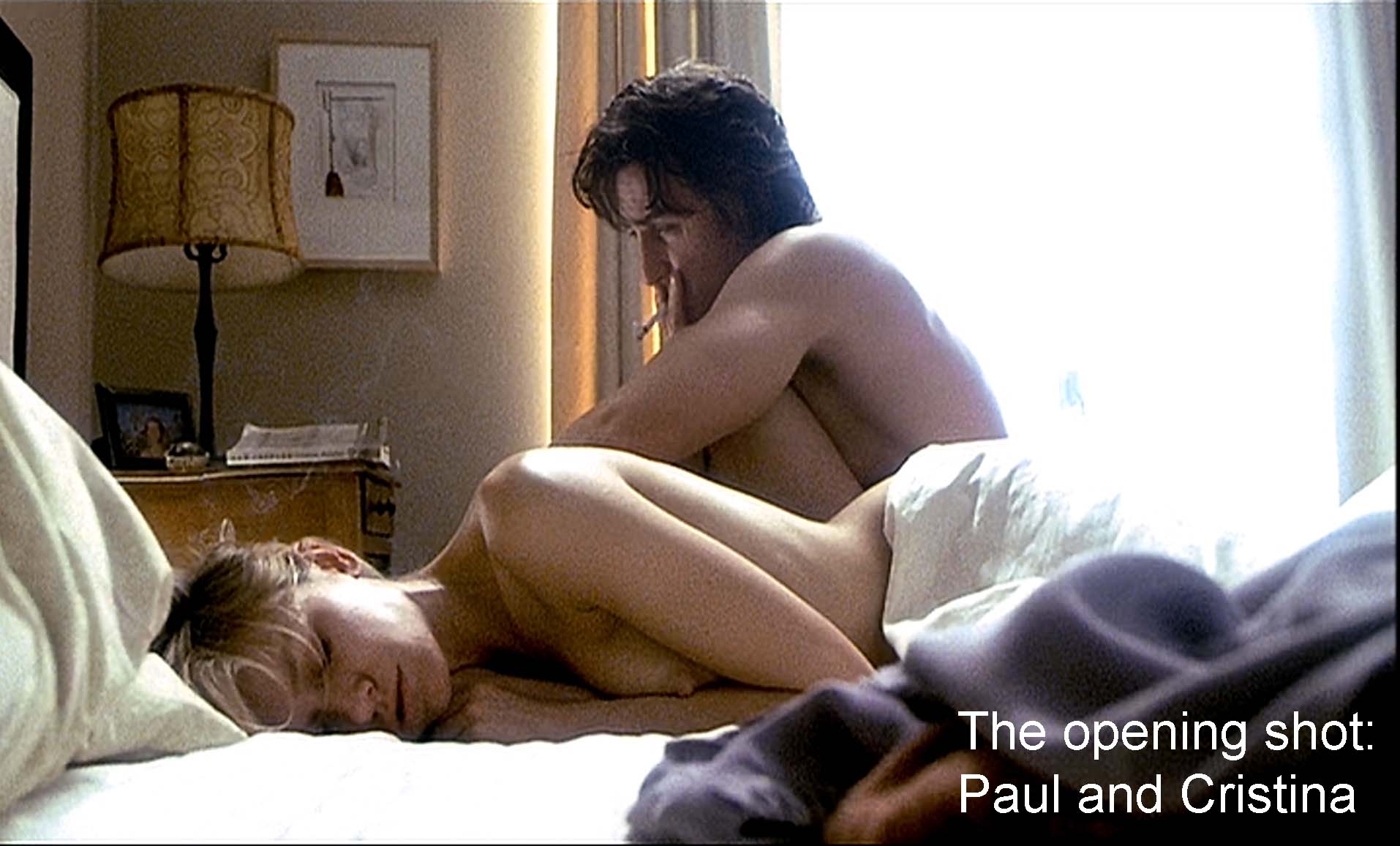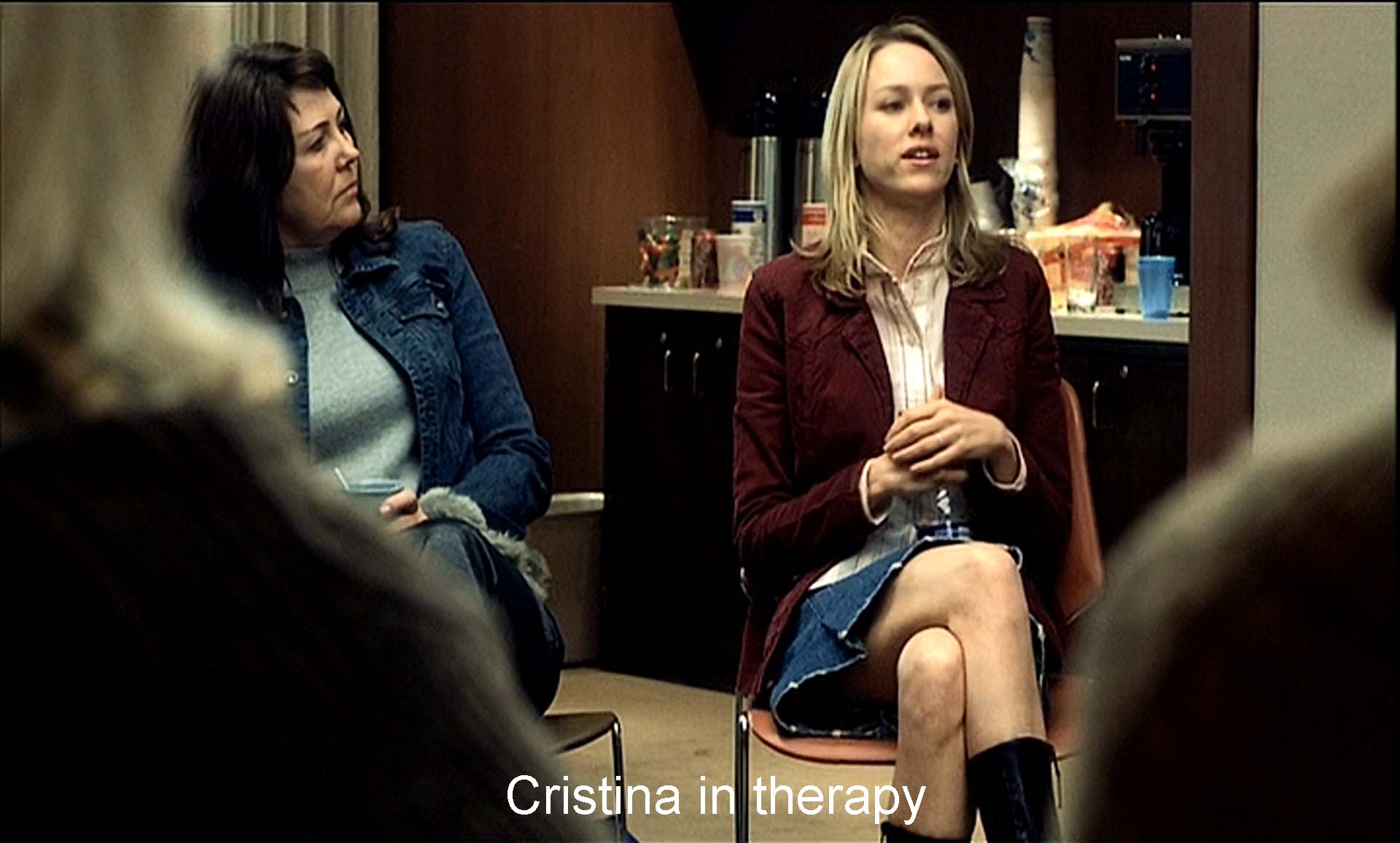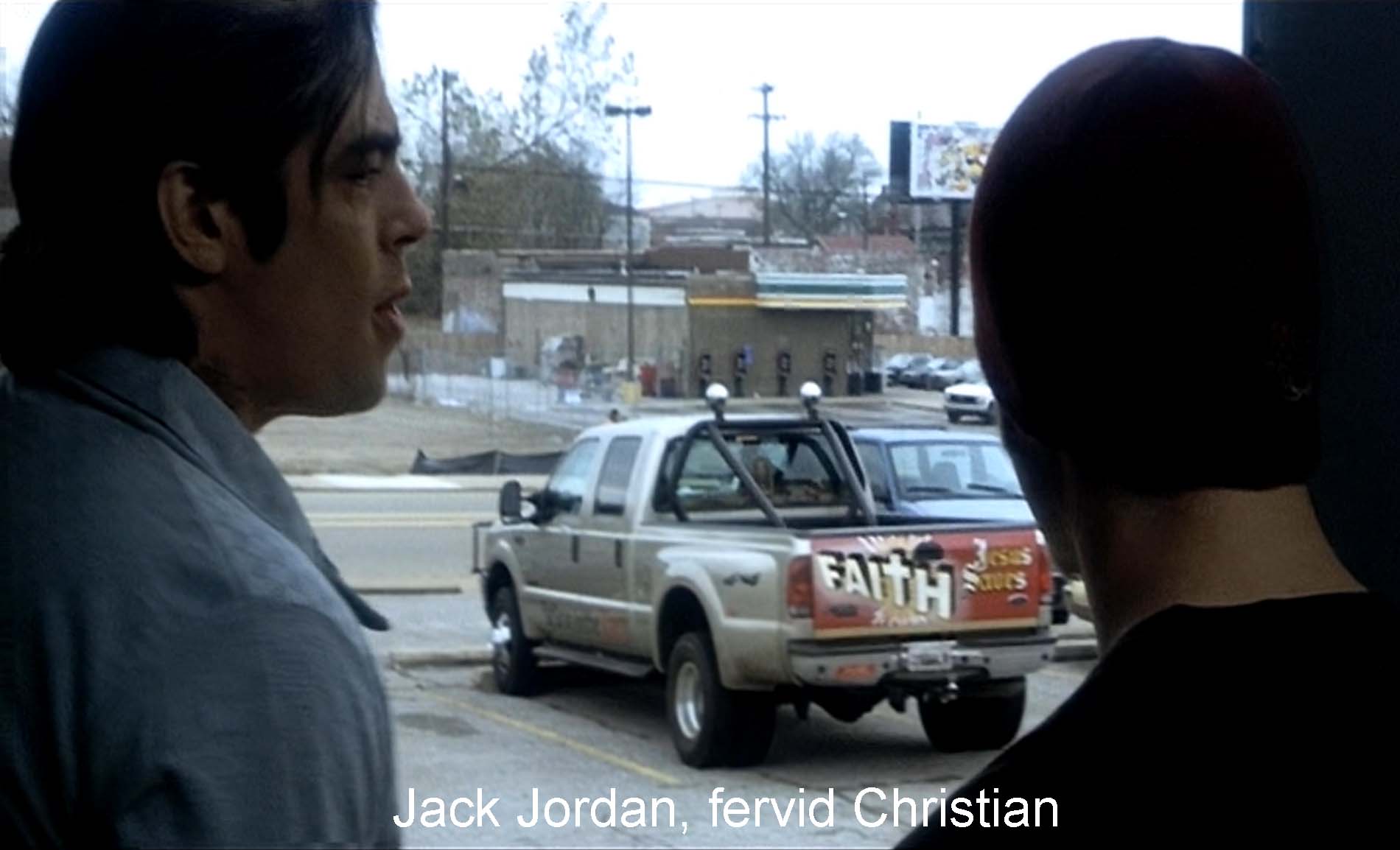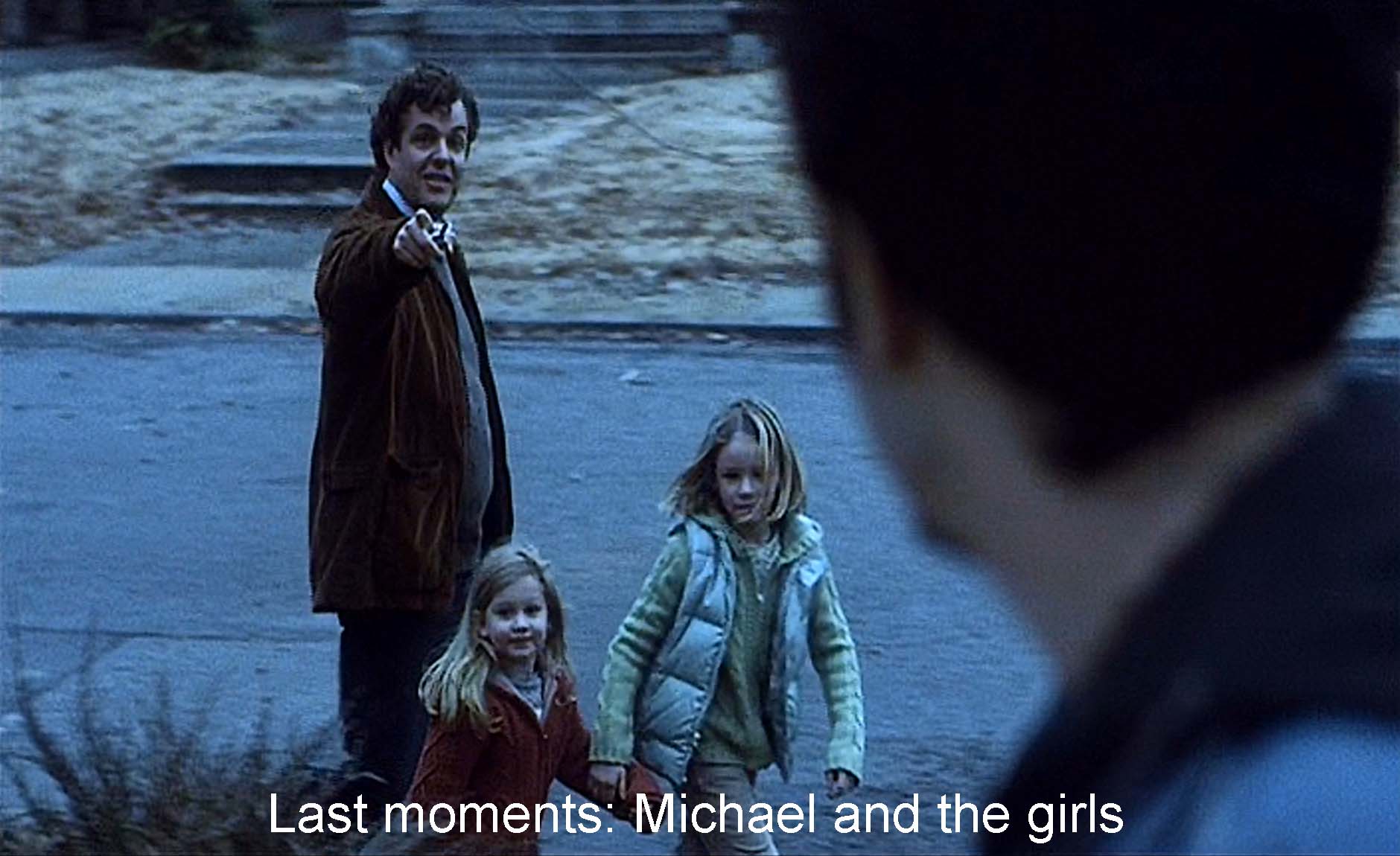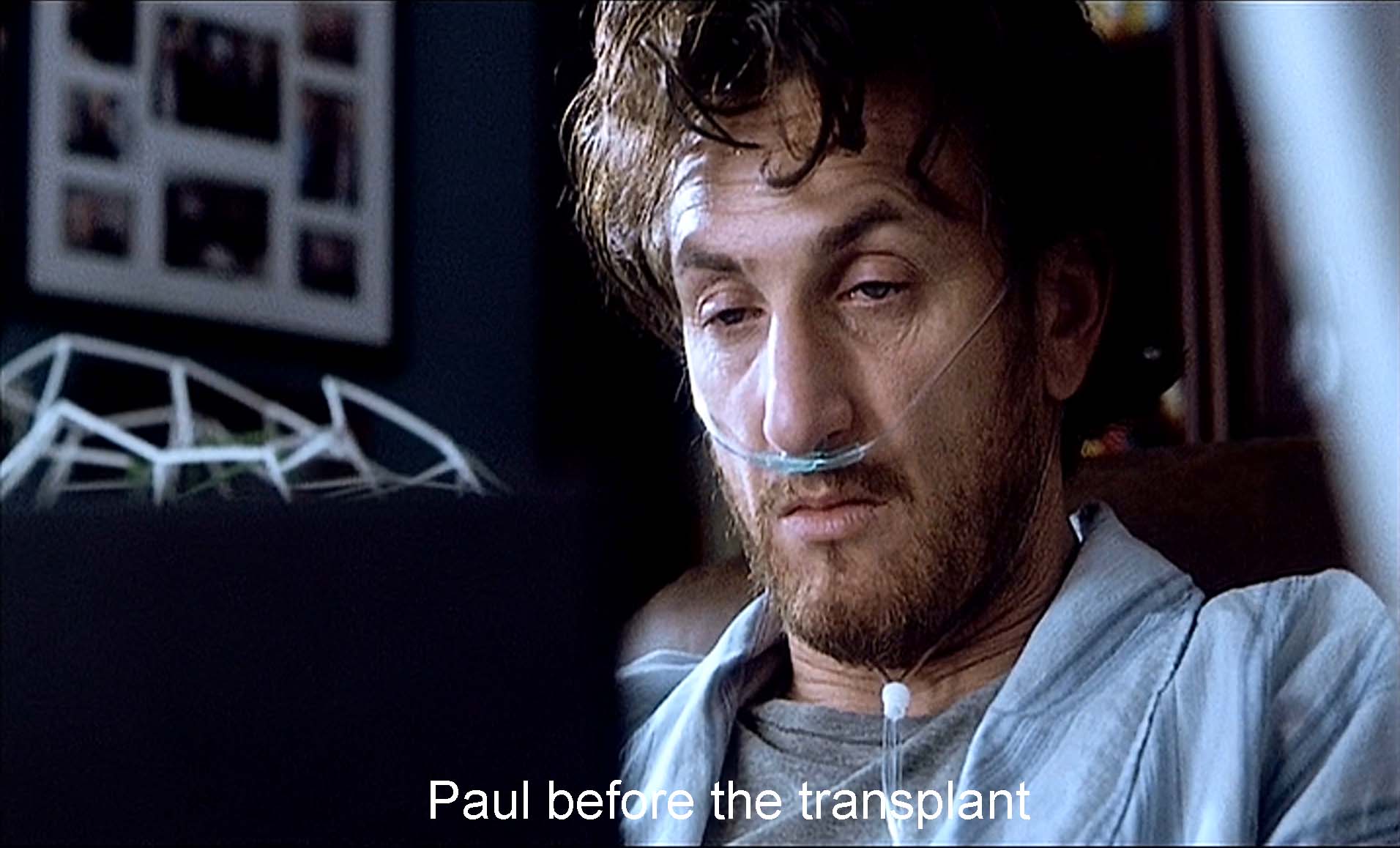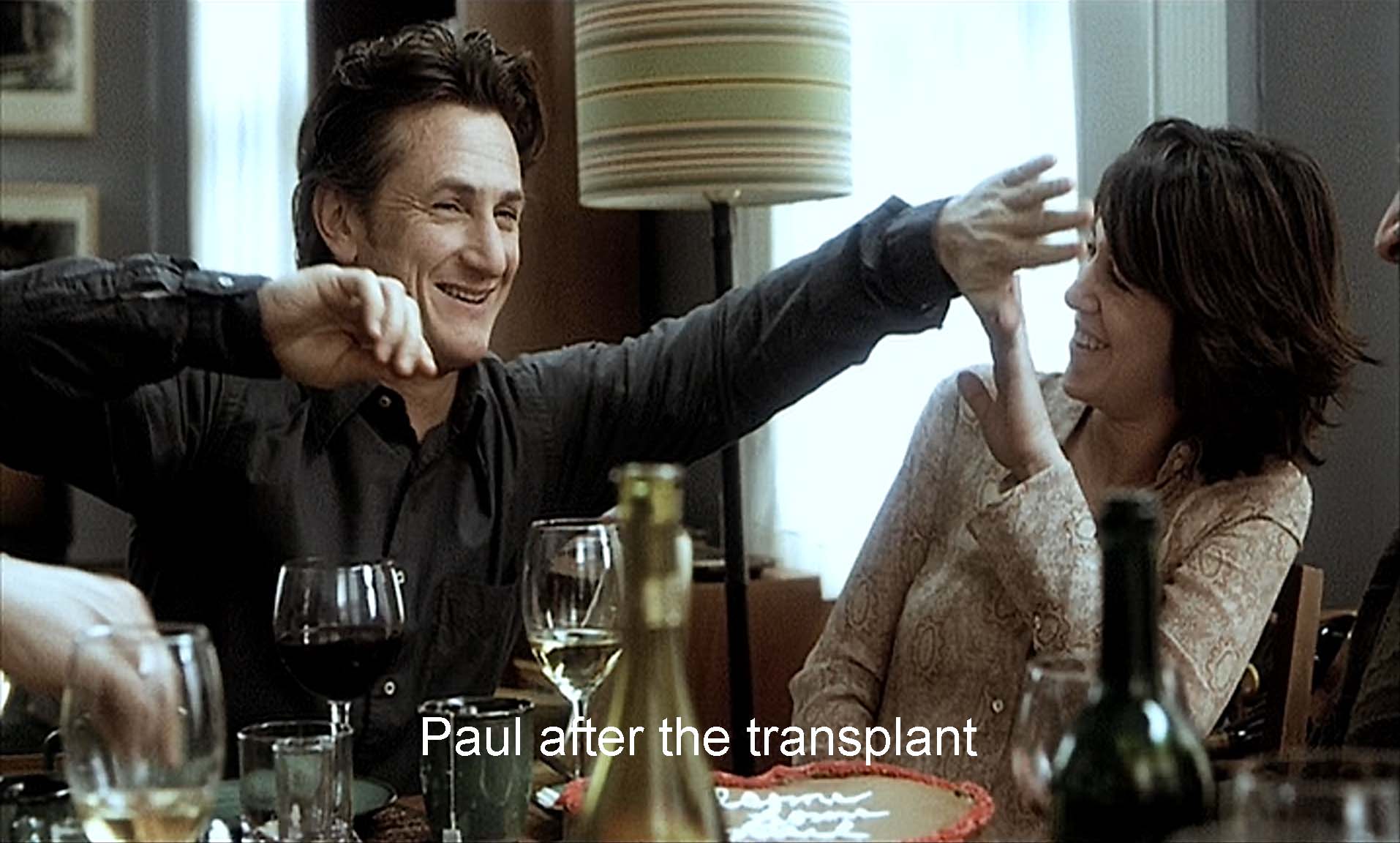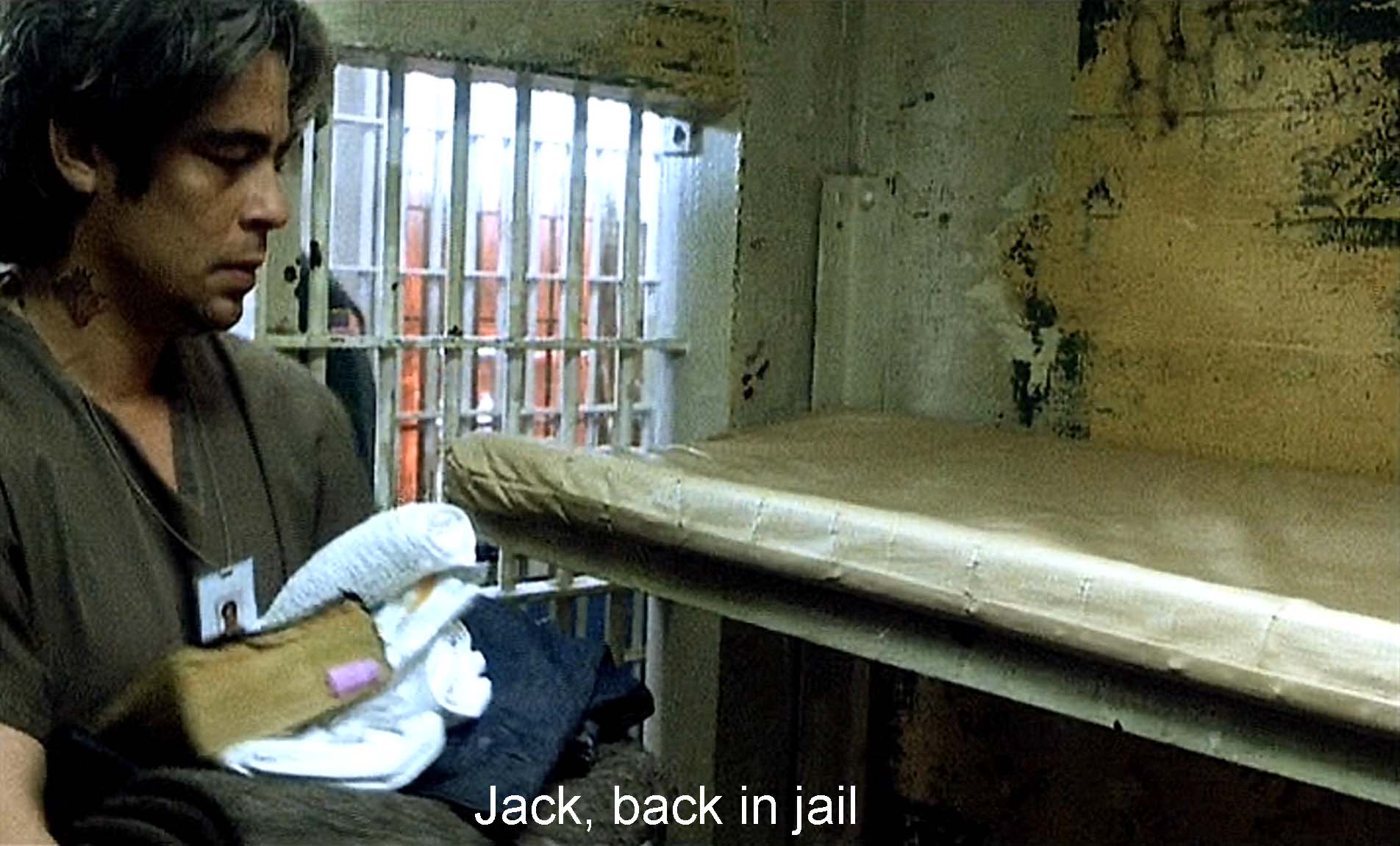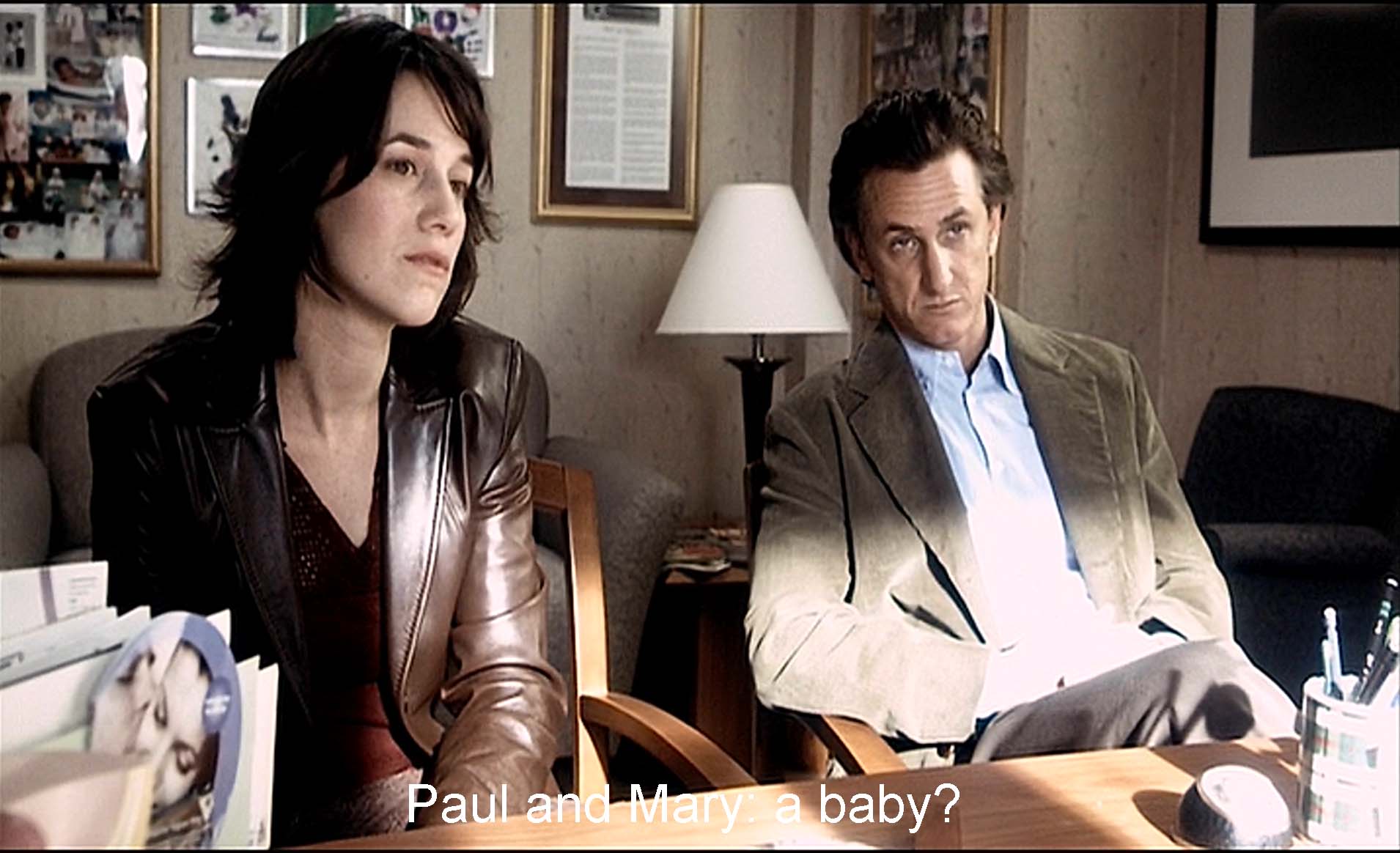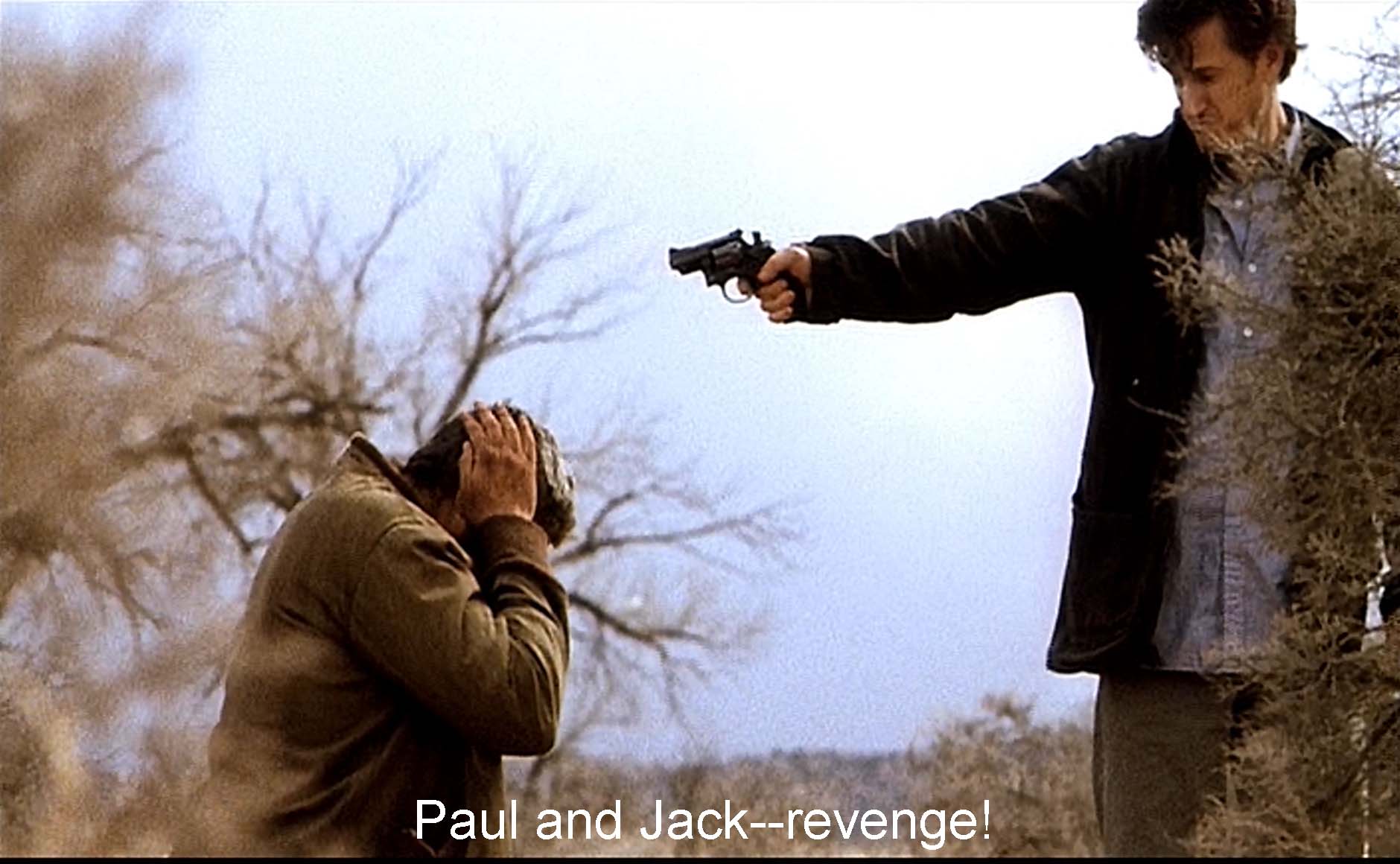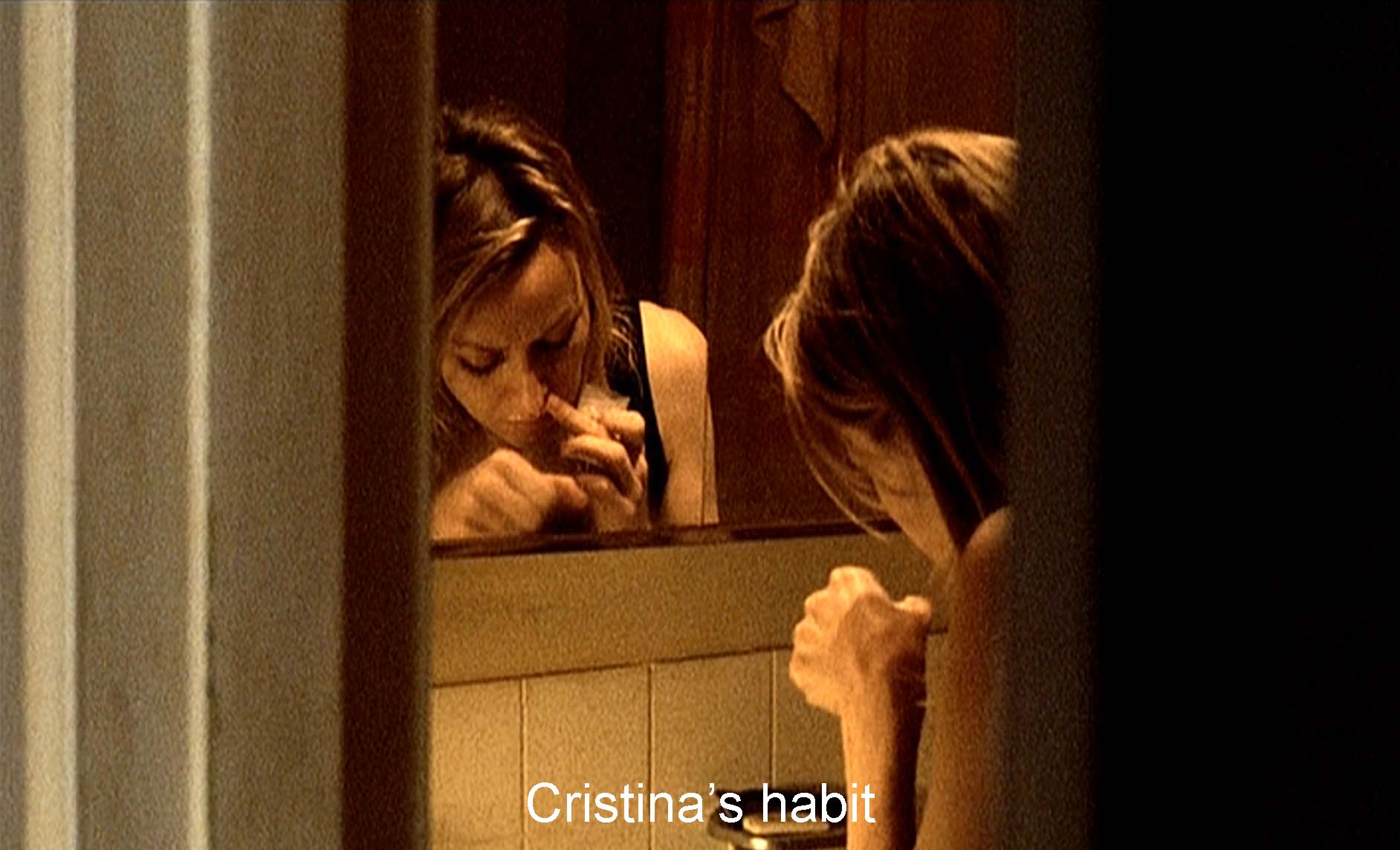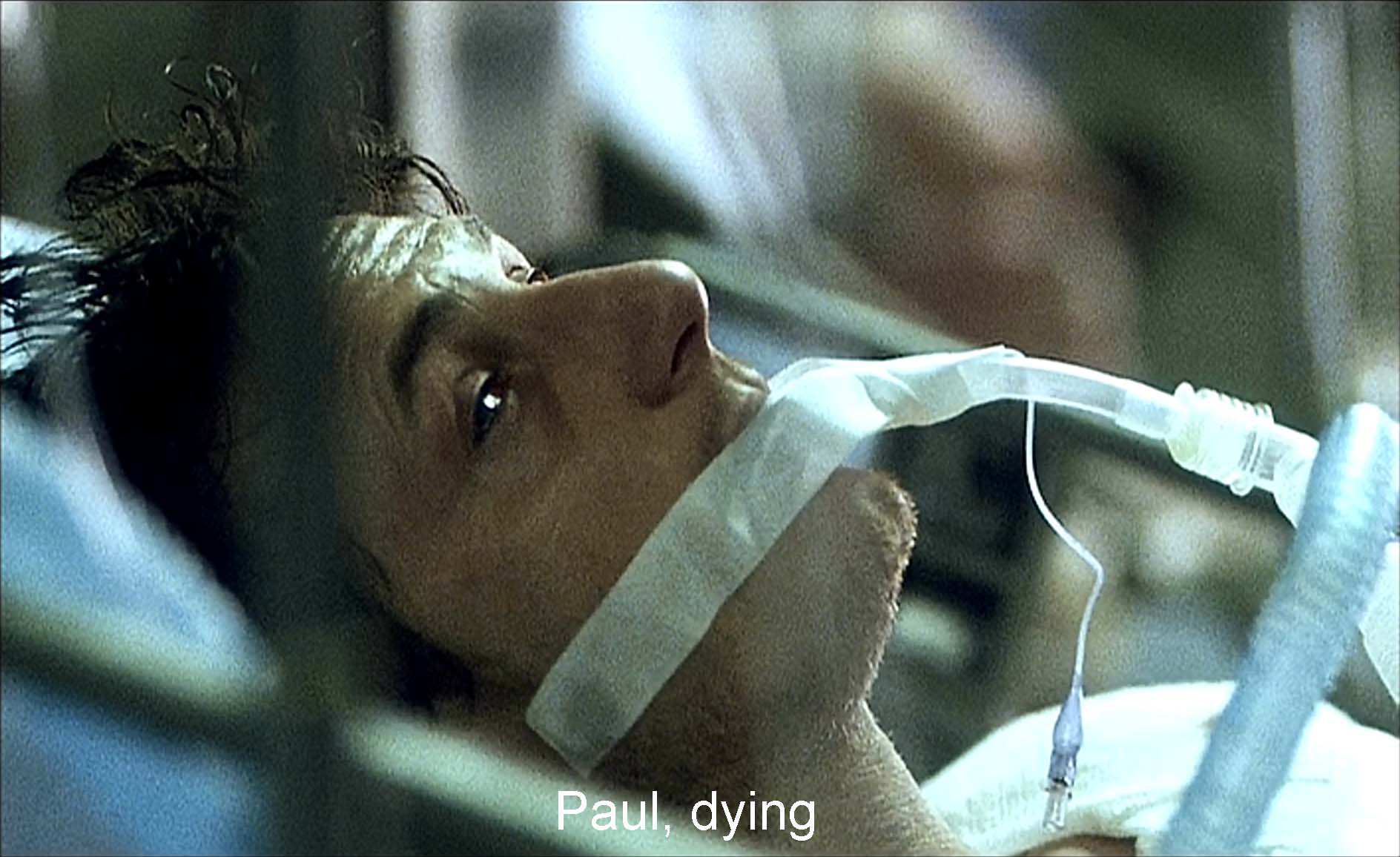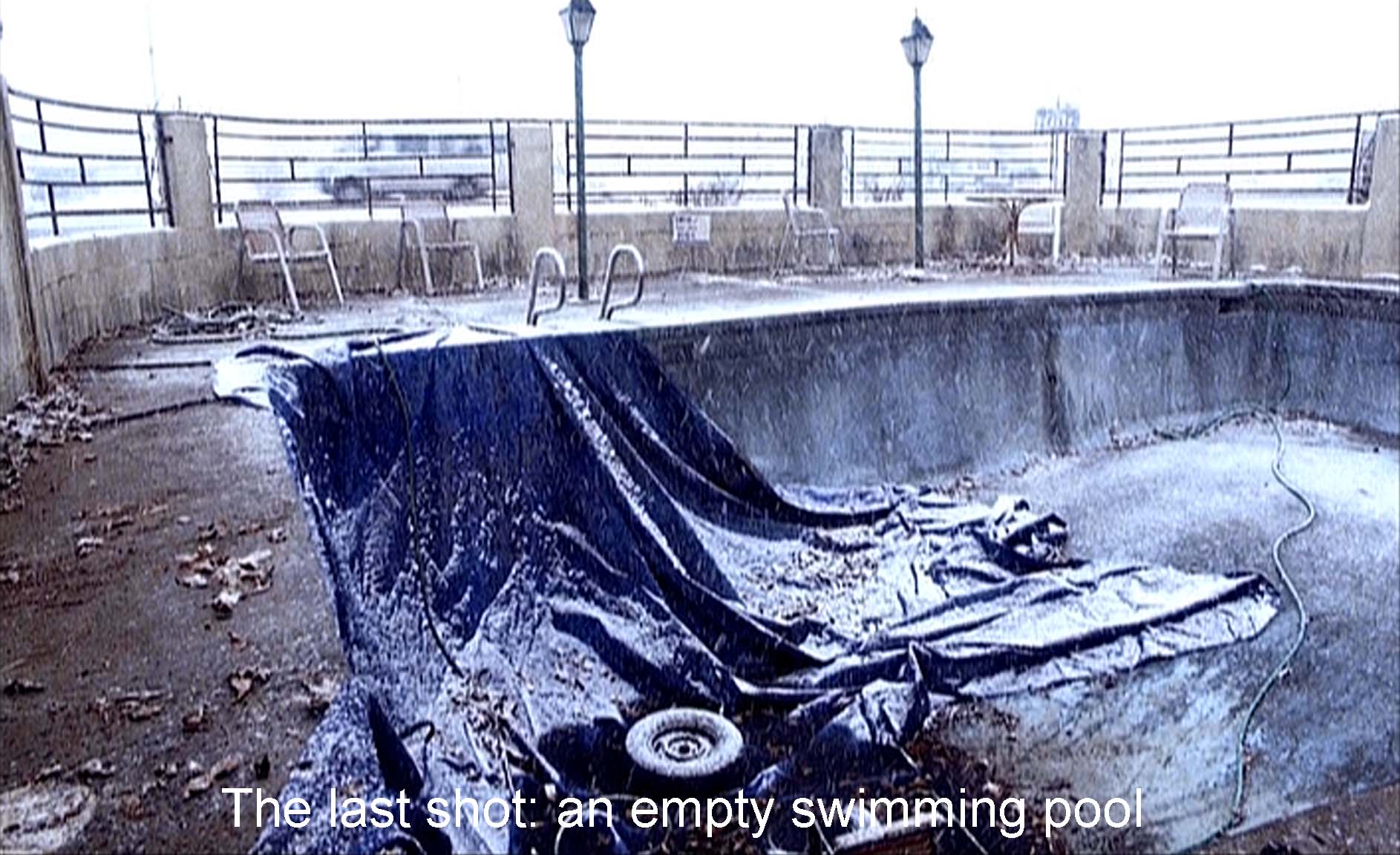21 Grams is a jigsaw movie, a real puzzle. For one thing the film never explains its enigmatic title until the last few minutes. “21 Grams.” The most intellectual of the three protagonists is dying and thinks (in voiceover and with unrelated shots interspersed in his meditation): “How many lives do we live? How many times do we die?” (He has, in a way, died once before.) “They say we all lose 21 grams at the exact moment of our death. Everyone.” “How much fits into 21 grams?” “How much is lost? How much is gained?” “The weight of a stack of five nickels. The weight of a chocolate bar. The weight of a hummingbird.” “How much did 21 grams weigh?” A shorter answer is, about two-thirds of an ounce, but that’s as not euphonious as 21 grams.
Is that folklore about 21 grams true? I doubt it. How would we ever know? By having people die while on incredibly accurate scales? And what is Paul talking about anyway, the human soul? Does it weigh 21 grams?
But the truth of the claim isn’t what matters. What matters for this film is that the title sets up a contrast between a physical reality that you can weigh in grams and a spiritual or psychic reality that you can’t measure, you can only experience. As the dying professor says, “I try to tell [my students] that numbers are a door to understanding a mystery that’s bigger than us.”
Like González Iñárritu’s first film, Amores perros (2000), 21 Grams has four central characters in three plots that all interpenetrate. But the time scheme of Amores perros was coherent compared to this. Shots in Amores occurred according to the sequence of events in the three plots.
This film completely scrambles the time scheme. At any given moment you could be watching any point whatever in the three plots. González Iñárritu has abandoned one-dimensional past, present, future for a two-dimensional time scheme that radiates out from the car crash on which all three plots pivot.
In an excellent study of 21 Grams in Sight and Sound, James Romney suggests that González Iñárritu wants us to take a god’s eye view of the events in the film. He wants us to see all of it, from beginning to end, at once, as if we were looking down at a map.
Think about time for a moment (no pun intended). Ordinarily we think of time as one-dimensional. Past, present, and future follow one another like a river flowing or like us walking a trail. In 21 Grams, time is two-dimensional, an area. Think of it as a circle with the hit-and-run accident at the center and different timelines as diameters running through it for the different characters: Jack, Paul, Cristina, and Mary. Instead of one time, there is a different time path across that area for each character. This is people-time instead of time-time.
In the first minutes of 21 Grams, you are seeing both the last moments of these four plots and things that happened before the action in the movie began. González Iñárritu himself has said that the film only comes together after about 25 minutes. And even after that, the film jumbles past, present, and future together. The New Yorker’s David Denby describes this as a style “that can leave the viewer experiencing reactions before actions, denouements before climaxes, disillusion before ecstasy, and many other upsetting reversals and discombobulations.” And he doesn’t like it. It submerges moral and emotional richness in an intellectual puzzle, he says. I was puzzled intellectually, yes, but at the same time I felt the characters and plots of 21 Grams in my heart—to pick up one of the key metaphors of the film.
Although González Iñárritu gives little visual clues throughout, I don’t think any normal viewer can put the jigsaw of this film together unless you know ahead of time who the four characters are and what the three plots are. To put the pieces together, the shots, you need the picture on the jigsaw puzzle’s box. If you want a pristine experience of the film, read no further. But if you’d like to get a better grasp the first time around, read on.
SPOILERS FOLLOW
As in Amores perros, one event ties the three plots together, an auto accident. (González Iñárritu’s collaborator on both films, the gifted screenwriter, Guillermo Arriaga, has said that he likes car crashes.) Jack Jordan, ex-con, ex-alcoholic, recently fired, is driving his truck (painted with Jesus-messages) home. Michael Peck is walking his two daughters home after they’ve been enjoying Cokes in a local eatery. Jordan runs over all three of them in an accident that we never see. The rest of the film, before the accident, at the same time as the accident, and after the accident, radiates out from that one unseen moment in time.
The obvious question that pops into mind is, Why? Why would a filmmaker organize a film this way? I think because González Iñárritu is making a film about connections, and he wants us in the audience to be trying to understand the connections as his characters are trying.
In the Jack Jordan plot, Jack (Benecio Del Toro) is an ex-con, recovering alcoholic, who has reformed by becoming a pathologically fervid Christian. His minister has to restrain him from angrily beating up a “punk” he is supposedly counselling. Then, his boss fires him from his caddying job because of his tattoos. Driving home, he runs over and kills Michael Peck (Danny Huston) and his two daughters who are also going home (making connections).
In the Paul Rivers plot, Paul (Sean Penn) is a professor of mathematics who is dying from heart failure. He is married to Mary (Charlotte Gainsbourg) who wants to conceive a child by him before he dies, although that’s doubtful, her Fallopian tubes having been damaged by an abortion when she was separated from Paul (because of his affairs with students). In the hospital, Paul gets Michael Peck’s heart, and he is a new man with a new life. Paul then wants to know and meet the widow of the man who (he feels) he now is.
She is Cristina Peck (Naomi Watts). Before her children were born she was hooked on drugs and alcohol, but her husband and children helped her get free. After they are killed, she crashes. Convinced that “life does not go on,” she resumes her addictions. When Paul finds her, he becomes obsessed with her (and his wife Mary, still planning artificial insemination, leaves). When Paul tells Cristina that he has Michael’s heart, she rages at him for insinuating himself into her life, but they fall in love (or lust) anyway. Then she wants Paul to kill Jack.
After the accident, Jack bowed to his Christ-inflected guilt and turned himself in. His wife Marianne (Melissa Leo) got him out of jail, him, against his will. Despairing of everything, he deserts his family and takes a construction job (symbolically) out in the desert. Paul and Cristina track him down there. In a final confrontation, Paul shoots himself and, dying, meditates on “21 Grams.”
The obvious question that pops into my mind is, Why? Why would a filmmaker organize a film in this chaotic way? I think he does because he is making a second film about connections, and he wants us in the audience to share his vision. He wants us to be trying to make connections as his characters are.
But ironically, the film is about connections broken. The accident destroys Cristina's family. The other characters don’t make connections. They break them. Jack deserts his family. Paul and Mary leave each other. We see Cristina disposing of her children's clothes and toys. Most crucially, Paul and Cristina think Jack is living a carefree life. They never know how crushed he is by guilt. “I ran away,” he repeats. It is the lack or breaking of connection that destroys.
As in Amores, González Iñárritu is giving us a vision of humans in an intricately interconnected world. Our lives are never free of our connections (or disconnections) to others. The best way for an audience to experience such a world is for us to have to make and recognize those connections for ourselves. Indeed we even see Cristina’s “connection,” her supplier of drugs.
That is the first of many puns and “echoes” (as I will call them) that you can discern in this film, like the “penetrations” and “intersections” that linked the three plots of Amores perros.
- Different characters in different contexts say, “Life goes on.”
- At different times, in different contexts, we hear Michael’s final cell phone message.
- The little girls’ last act was chasing a pigeon, and twice González Iñárritu gives us a cutaway shot of a flock of birds flying. At the beginning of the picture, they are going up, left to right; at the end, they go down right to left. Are they omens bookending the picture?
- The last shot is of an empty swimming pool, echoing the desolation at the end of this movie. Yet, earlier, Cristina had said of her swimming pool, “It keeps me alive.”
- A sports club, healthy, contrasts with a night club, unhealthy.
- González Iñárritu cuts from Mary washing glasses to Cristina talking about glasses.
- Paul and Jack both have celebratory parties. At Jack’s someone tells a bawdy joke about “What time does your husband come home?” and that’s exactly the problem with the crash at the center of this movie, coming home.
- Having sex with his wife, Jack’s guilt kicks in and he recalls little Katie’s dying: “She looked me in the eyes.” Later, when Paul threatens to shoot Jack, he says to him, “Don’t look at me.”
- Mary and Cristina both get pregnant by Paul.
- Paul, dying, complains of the tubes he is hooked up to. Earlier Mary’s damaged Fallopian tubes may prevent her getting pregnant again.
- Cristina’s therapy session contrasts with Jack’s giving Christian “therapy.” He tells a “punk” to think; then his minister tells him the same.
- Paul, shadowing Cristina, watches her buy wine, wine she will later serve him when he comes to her home. She says to him, “Will you stick with red?” Later she speaks of little Katie’s red shoelaces. Earlier, she had stared at them while washing her dead children’s clothes.
- Color forms part of the echoing. González Iñárritu and his production designer Brigitte Broch and cinematographer Rodrigo Prieto deliberately associated colors with the different plots. Jack’s world is red-orange (lit with sodium-vapor lamps or orange gels). Paul’s plot is in white or blue (the night colors created by metal halide lamps). Cristina’s plot draws on both color schemes. In the final confrontation, all the action is in red-orange-tan.
I am sure there are more echoes than these. A director as skilled as González Iñárritu chooses details of dialogue and image to involve us in his theme. Here, these echoes let us, his audience, make for ourselves his film’s governing theme, connections.
González Iñárritu also provides visual and verbal puns. Puns play (like the legend of “21 Grams”) with the relation between the physical word and its abstract meaning. Paul jokes when declaring his affection for Cristina, “I’ve got a good heart.” Before the crash the girls are enjoying Cokes and we have just seen a shot of Cristina doing “coke.” The congregation at Jack’s church sings, “I’ve got peace like a river”; he is named Jordan and Paul is named Rivers, but they represent anything but peace. Cristina’s name Peck may, like 21 Grams, combine quantity with the unquantifiable, as in the song, “I love you a bushel and a peck,” which goes on, “A bushel and a peck though you make my heart a wreck / Make my heart a wreck and you make my life a mess.”
Then there are visual puns that seem so improbable that I hesitate to suggest them. Paul plays chess while his chest is failing. There is a cutaway shot to a squash game when the central issue of this film is people being squashed in an accident. Yet why else did González Iñárritu put in these incidental shots of chess and squash? There are probably others I didn’t catch.
Addiction, swimming, surgery, killing, above all, the fatal accident—the connections this film makes are body connections. Most centrally, Paul gets Michael’s heart. Mary wants Paul’s baby, and Cristina has gotten pregnant by him. The first shot of the film shows Paul sitting on the bed, Cristina still asleep, after they have had sex. He had met her through her body at a swimming pool, later when zonked out with drugs. Jack gets fired because he has tattoos. He hits his son while shouting, “There’s no hitting in this house.” There are matching addictions, Paul’s to smoking, Cristina’s to drugs, Jack’s to alcohol and Christ. Paul dies, perhaps because his body can’t accept Cristina’s drug-tainted blood. Making physical, bodily connections (like coming home, supporting your wife or your family, giving blood) is good. Breaking those connections with “bad blood” is not good.
In short, I don’t agree with Denby that González Iñárritu abandons moral and emotional concerns to create an intellectual puzzle of a movie. Yes, 21 Grams is an intellectual puzzle and solving it is one way we can enjoy the movie. Yet the event at the center of the puzzle is an automobile accident and its effects on all these people touched by it is devastating. Guilt, sadness, regret, grief, despair—when I see this film I share all these emotions. Most importantly, I am simultaneously aware of the relation between the physical deaths and the spiritual deaths all three of the major characters experience. That relation is what makes the title that combines a physical and a spiritual quality so telling.
González Iñárritu has created a stunning movie, perhaps a masterpiece for all its strangeness. Throughout, he shows an amazing dexterity with details so that we can ourselves bring into an artistic wholeness what seems at first a baffling jumble of separate shots. He engages us in the very task the characters are involved in. We too have to try to translate our wishes for a world or a work of art that makes psychological or spiritual sense into a physical reality. The characters fail. We, however, can succeed, thanks to this breathtaking film.
